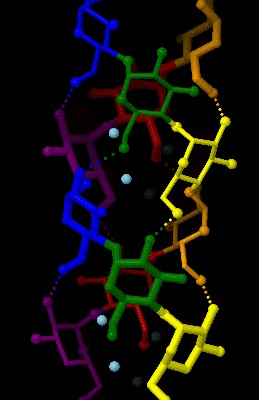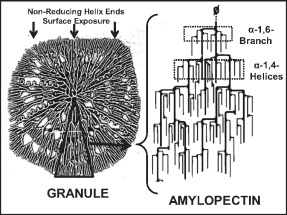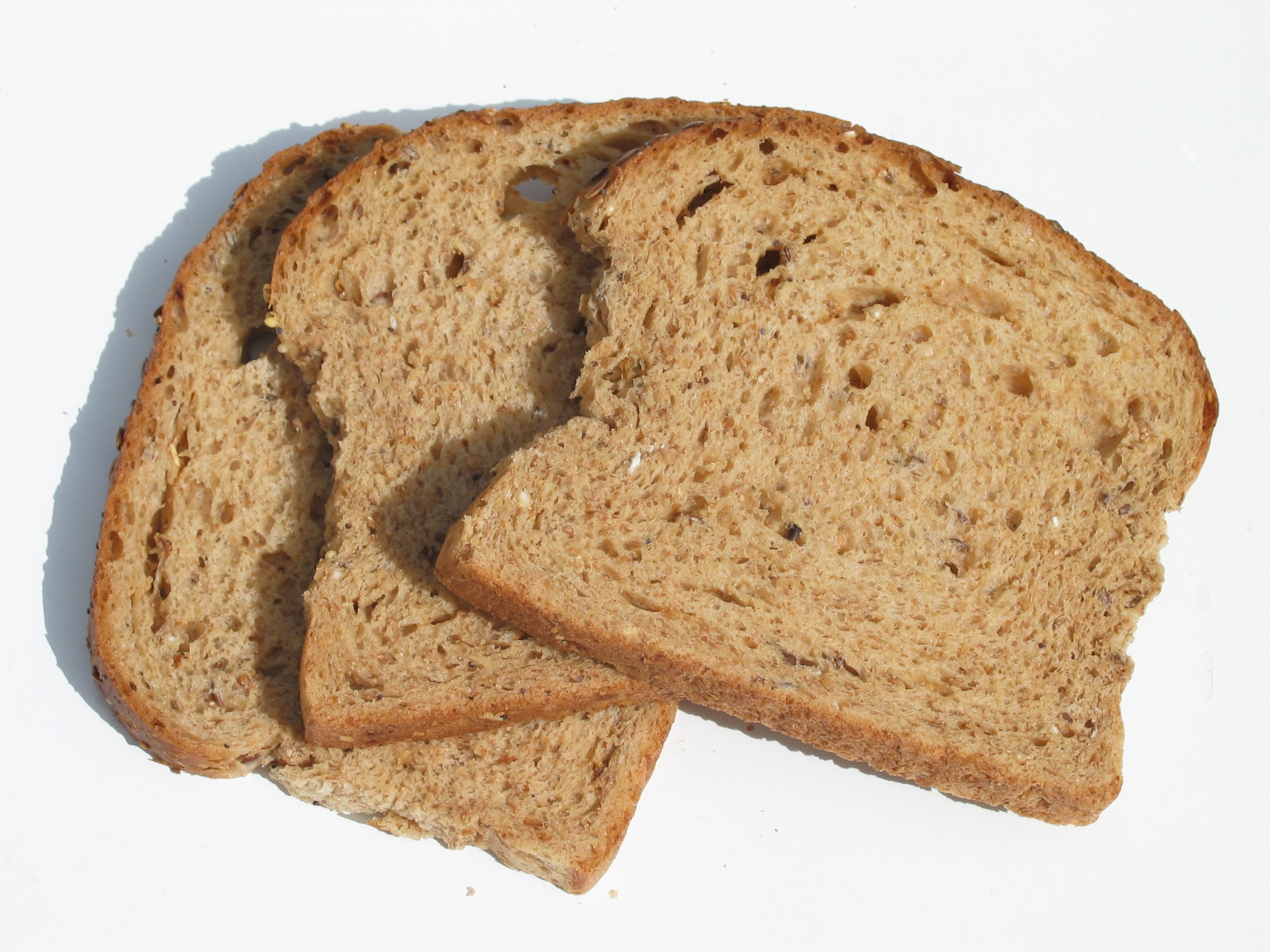|
Retrogradation (starch)
Retrogradation is a reaction that takes place when the amylose and amylopectin chains in cooked, gelatinized starch realign themselves as the cooked starch cools. When native starch is heated and dissolved in water, the crystalline structure of amylose and amylopectin molecules is lost and they hydrate to form a viscous solution. If the viscous solution is cooled or left at lower temperature for a long enough period, the linear molecules, amylose, and linear parts of amylopectin molecules retrograde and rearrange themselves again to a more crystalline structure. The linear chains place themselves parallel and form hydrogen bridges. In viscous solutions the viscosity increases to form a gel. At temperatures between –8 and +8 °C the aging process is enhanced drastically. Amylose crystallization occurs much faster than crystallization of the amylopectin. The crystal melting temperature of amylose is much higher (about 150 ℃) than amylopectin (about 50–60 ℃). The tempera ... [...More Info...] [...Related Items...] OR: [Wikipedia] [Google] [Baidu] |
Amylose
Amylose is a polysaccharide made of α-D-glucose units, bonded to each other through α(1→4) glycosidic bonds. It is one of the two components of starch, making up approximately 20–30%. Because of its tightly packed helical structure, amylose is more resistant to digestion than other starch molecules and is therefore an important form of resistant starch. Structure Amylose is made up of α(1→4) bound glucose molecules. The carbon atoms on glucose are numbered, starting at the aldehyde (C=O) carbon, so, in amylose, the 1-carbon on one glucose molecule is linked to the 4-carbon on the next glucose molecule (α(1→4) bonds). The structural formula of amylose is pictured at right. The number of repeated glucose subunits (n) is usually in the range of 300 to 3000, but can be many thousands. There are three main forms of amylose chains can take. It can exist in a disordered amorphous conformation or two different helical forms. It can bind with itself in a double helix (A or ... [...More Info...] [...Related Items...] OR: [Wikipedia] [Google] [Baidu] |
Amylopectin
Amylopectin is a water-insoluble polysaccharide and highly branched polymer of α-glucose units found in plants. It is one of the two components of starch, the other being amylose. Plants store starch within specialized organelles called amyloplasts. To generate energy, the plant hydrolyzes the starch, releasing the glucose subunits. Humans and other animals that eat plant foods also use amylase, an enzyme that assists in breaking down amylopectin, to initiate the hydrolyzation of starch. Starch is made of about 70–80% amylopectin by weight, though it varies depending on the source. For example, it ranges from lower percent content in long-grain rice, amylomaize, and russet potatoes to 100% in glutinous rice, waxy potato starch, and waxy corn. Amylopectin is highly branched, being formed of 2,000 to 200,000 glucose units. Its inner chains are formed of 20–24 glucose subunits. Dissolved amylopectin starch has a lower tendency of retrogradation (a partial recrystallization a ... [...More Info...] [...Related Items...] OR: [Wikipedia] [Google] [Baidu] |
Starch Gelatinization
Starch gelatinization is a process of breaking down the intermolecular bonds of starch molecules in the presence of water and heat, allowing the hydrogen bonding sites (the hydroxyl hydrogen and oxygen) to engage more water. This irreversibly dissolves the starch granule in water. Water acts as a plasticizer. Three main processes happen to the starch granule: granule swelling, crystallite or double helical melting, and amylose leaching. *During heating, water is first absorbed in the amorphous space of starch, which leads to a swelling phenomenon. *Water then enters via amorphous regions into the tightly bound areas of double helical structures of amylopectin. At ambient temperatures these crystalline regions do not allow water to enter. Heat causes such regions to become diffuse, the amylose chains begin to dissolve, to separate into an amorphous form and the number and size of crystalline regions decreases. Under the microscope in polarized light starch loses its bire ... [...More Info...] [...Related Items...] OR: [Wikipedia] [Google] [Baidu] |
Starch
Starch or amylum is a polymeric carbohydrate consisting of numerous glucose units joined by glycosidic bonds. This polysaccharide is produced by most green plants for energy storage. Worldwide, it is the most common carbohydrate in human diets, and is contained in large amounts in staple foods such as wheat, potatoes, maize (corn), rice, and cassava (manioc). Pure starch is a white, tasteless and odorless powder that is insoluble in cold water or alcohol. It consists of two types of molecules: the linear and helical amylose and the branched amylopectin. Depending on the plant, starch generally contains 20 to 25% amylose and 75 to 80% amylopectin by weight. Glycogen, the energy reserve of animals, is a more highly branched version of amylopectin. In industry, starch is often converted into sugars, for example by malting. These sugars may be fermented to produce ethanol in the manufacture of beer, whisky and biofuel. In addition, sugars produced from processed starch are used ... [...More Info...] [...Related Items...] OR: [Wikipedia] [Google] [Baidu] |
Viscosity
The viscosity of a fluid is a measure of its resistance to deformation at a given rate. For liquids, it corresponds to the informal concept of "thickness": for example, syrup has a higher viscosity than water. Viscosity quantifies the internal frictional force between adjacent layers of fluid that are in relative motion. For instance, when a viscous fluid is forced through a tube, it flows more quickly near the tube's axis than near its walls. Experiments show that some stress (such as a pressure difference between the two ends of the tube) is needed to sustain the flow. This is because a force is required to overcome the friction between the layers of the fluid which are in relative motion. For a tube with a constant rate of flow, the strength of the compensating force is proportional to the fluid's viscosity. In general, viscosity depends on a fluid's state, such as its temperature, pressure, and rate of deformation. However, the dependence on some of these properties is ... [...More Info...] [...Related Items...] OR: [Wikipedia] [Google] [Baidu] |
Crystallization
Crystallization is the process by which solid forms, where the atoms or molecules are highly organized into a structure known as a crystal. Some ways by which crystals form are precipitating from a solution, freezing, or more rarely deposition directly from a gas. Attributes of the resulting crystal depend largely on factors such as temperature, air pressure, and in the case of liquid crystals, time of fluid evaporation. Crystallization occurs in two major steps. The first is nucleation, the appearance of a crystalline phase from either a supercooled liquid or a supersaturated solvent. The second step is known as crystal growth, which is the increase in the size of particles and leads to a crystal state. An important feature of this step is that loose particles form layers at the crystal's surface and lodge themselves into open inconsistencies such as pores, cracks, etc. The majority of minerals and organic molecules crystallize easily, and the resulting crystals are g ... [...More Info...] [...Related Items...] OR: [Wikipedia] [Google] [Baidu] |
Hydrogen Bond
In chemistry, a hydrogen bond (or H-bond) is a primarily electrostatic force of attraction between a hydrogen (H) atom which is covalently bound to a more electronegative "donor" atom or group (Dn), and another electronegative atom bearing a lone pair of electrons—the hydrogen bond acceptor (Ac). Such an interacting system is generally denoted , where the solid line denotes a polar covalent bond, and the dotted or dashed line indicates the hydrogen bond. The most frequent donor and acceptor atoms are the second-row elements nitrogen (N), oxygen (O), and fluorine (F). Hydrogen bonds can be intermolecular (occurring between separate molecules) or intramolecular (occurring among parts of the same molecule). The energy of a hydrogen bond depends on the geometry, the environment, and the nature of the specific donor and acceptor atoms and can vary between 1 and 40 kcal/mol. This makes them somewhat stronger than a van der Waals interaction, and weaker than fully covalent ... [...More Info...] [...Related Items...] OR: [Wikipedia] [Google] [Baidu] |
Syneresis (chemistry)
Syneresis (also spelled 'synæresis' or 'synaeresis'), in chemistry, is the extraction or expulsion of a liquid from a gel, such as when serum drains from a contracting clot of blood. Another example of syneresis is the collection of whey on the surface of yogurt. Syneresis can also be observed when the amount of diluent in a swollen polymer exceeds the solubility limit as the temperature changes. A household example of this is the counterintuitive expulsion of water from dry gelatin when the temperature increases. Syneresis has also been proposed as the mechanism of formation for the amorphous silicate composing the frustule of diatoms. Examples In the processing of dairy milk, for example during cheese making, syneresis is the formation of the curd due to the sudden removal of the hydrophilic macropeptides, which causes an imbalance in intermolecular forces. Bonds between hydrophobic sites start to develop and are enforced by calcium bonds, which form as the water molecules ... [...More Info...] [...Related Items...] OR: [Wikipedia] [Google] [Baidu] |
Staling
Staling, or "going stale", is a chemical and physical process in bread and similar foods that reduces their palatability - stale bread is dry and hard. Mechanism and effects Staling is not simply a drying-out process due to evaporation. One important mechanism is the migration of moisture from the starch granules into the interstitial spaces, degelatinizing the starch. The starch amylose and amylopectin molecules realign themselves causing recrystallisation. This results in stale bread's leathery, hard texture. Bread will stale even in a moist environment, and stales most rapidly at temperatures just above freezing. While bread that has been frozen when fresh may be thawed acceptably, bread stored in a refrigerator will have increased staling rates. Countermeasures Anti-staling agents used in modern bread include wheat gluten, enzymes, and glycerolipids, mainly monoglycerides and diglycerides. Culinary uses Many classic dishes rely upon otherwise unpalatable stale bread. E ... [...More Info...] [...Related Items...] OR: [Wikipedia] [Google] [Baidu] |
Resistant Starch
Resistant starch (RS) is starch, including its degradation products, that escapes from digestion in the small intestine of healthy individuals. Resistant starch occurs naturally in foods, but it can also be added as part of dried raw foods, or used as an additive in manufactured foods. Some types of resistant starch (RS1, RS2 and RS3) are fermented by the large intestinal microbiota, conferring benefits to human health through the production of short-chain fatty acids, increased bacterial mass, and promotion of butyrate-producing bacteria. Resistant starch has similar physiological effects as dietary fiber, behaving as a mild laxative and possibly causing flatulence. Origin and history The concept of resistant starch arose from research in the 1970s and is currently considered to be one of three starch types: rapidly digested starch, slowly digested starch and resistant starch, each of which may affect levels of blood glucose. The European Commission supported research event ... [...More Info...] [...Related Items...] OR: [Wikipedia] [Google] [Baidu] |
Modified Starch
Modified starch, also called starch derivatives, are prepared by physically, enzymatically, or chemically treating native starch to change its properties. Modified starches are used in practically all starch applications, such as in food products as a thickening agent, stabilizer or emulsifier; in pharmaceuticals as a disintegrant; or as binder in coated paper. They are also used in many other applications. Starches are modified to enhance their performance in different applications. Starches may be modified to increase their stability against excessive heat, acid, shear, time, cooling, or freezing; to change their texture; to decrease or increase their viscosity; to lengthen or shorten gelatinization time; or to increase their visco-stability. Modification methods Acid-treated starch (INS 1401), also called thin boiling starch, is prepared by treating starch or starch granules with inorganic acids, e.g. hydrochloric acid breaking down the starch molecule and thus reduc ... [...More Info...] [...Related Items...] OR: [Wikipedia] [Google] [Baidu] |
Glucose
Glucose is a simple sugar with the molecular formula . Glucose is overall the most abundant monosaccharide, a subcategory of carbohydrates. Glucose is mainly made by plants and most algae during photosynthesis from water and carbon dioxide, using energy from sunlight, where it is used to make cellulose in cell walls, the most abundant carbohydrate in the world. In energy metabolism, glucose is the most important source of energy in all organisms. Glucose for metabolism is stored as a polymer, in plants mainly as starch and amylopectin, and in animals as glycogen. Glucose circulates in the blood of animals as blood sugar. The naturally occurring form of glucose is -glucose, while -glucose is produced synthetically in comparatively small amounts and is less biologically active. Glucose is a monosaccharide containing six carbon atoms and an aldehyde group, and is therefore an aldohexose. The glucose molecule can exist in an open-chain (acyclic) as well as ring (cyclic) form. Gluco ... [...More Info...] [...Related Items...] OR: [Wikipedia] [Google] [Baidu] |







